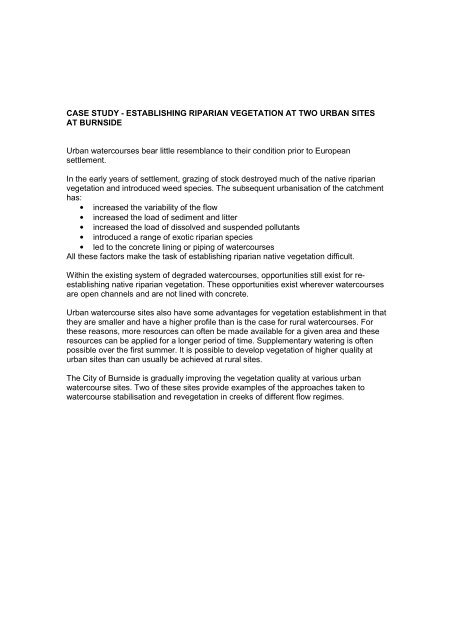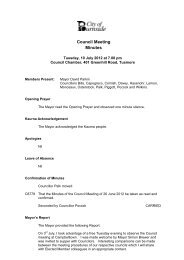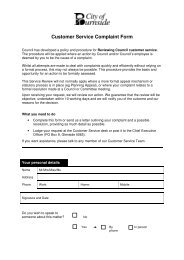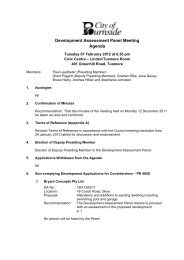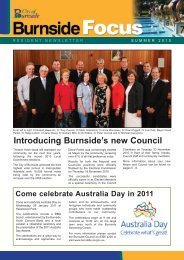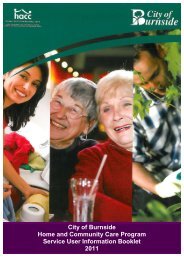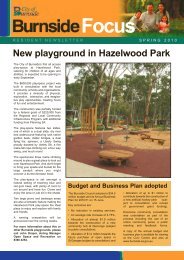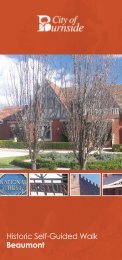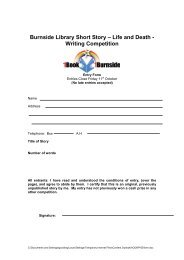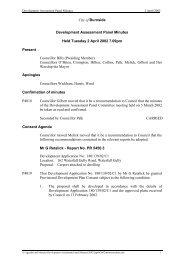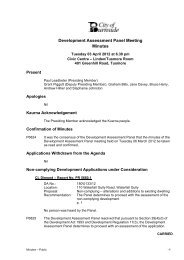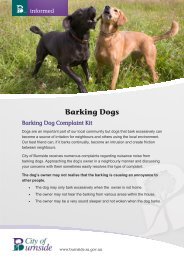ESTABLISHING RIPARIAN VEGETATION AT TWO ... - City of Burnside
ESTABLISHING RIPARIAN VEGETATION AT TWO ... - City of Burnside
ESTABLISHING RIPARIAN VEGETATION AT TWO ... - City of Burnside
- No tags were found...
You also want an ePaper? Increase the reach of your titles
YUMPU automatically turns print PDFs into web optimized ePapers that Google loves.
CASE STUDY - <strong>ESTABLISHING</strong> <strong>RIPARIAN</strong> <strong>VEGET<strong>AT</strong>ION</strong> <strong>AT</strong> <strong>TWO</strong> URBAN SITES<strong>AT</strong> BURNSIDEUrban watercourses bear little resemblance to their condition prior to Europeansettlement.In the early years <strong>of</strong> settlement, grazing <strong>of</strong> stock destroyed much <strong>of</strong> the native riparianvegetation and introduced weed species. The subsequent urbanisation <strong>of</strong> the catchmenthas:• increased the variability <strong>of</strong> the flow• increased the load <strong>of</strong> sediment and litter• increased the load <strong>of</strong> dissolved and suspended pollutants• introduced a range <strong>of</strong> exotic riparian species• led to the concrete lining or piping <strong>of</strong> watercoursesAll these factors make the task <strong>of</strong> establishing riparian native vegetation difficult.Within the existing system <strong>of</strong> degraded watercourses, opportunities still exist for reestablishingnative riparian vegetation. These opportunities exist wherever watercoursesare open channels and are not lined with concrete.Urban watercourse sites also have some advantages for vegetation establishment in thatthey are smaller and have a higher pr<strong>of</strong>ile than is the case for rural watercourses. Forthese reasons, more resources can <strong>of</strong>ten be made available for a given area and theseresources can be applied for a longer period <strong>of</strong> time. Supplementary watering is <strong>of</strong>tenpossible over the first summer. It is possible to develop vegetation <strong>of</strong> higher quality aturban sites than can usually be achieved at rural sites.The <strong>City</strong> <strong>of</strong> <strong>Burnside</strong> is gradually improving the vegetation quality at various urbanwatercourse sites. Two <strong>of</strong> these sites provide examples <strong>of</strong> the approaches taken towatercourse stabilisation and revegetation in creeks <strong>of</strong> different flow regimes.
1999 Creek at Beaumont Common – engineering works complete2005 Creek at Beaumont Common – riparian native vegetation established
2003 Second Creek at Simpson Reserve – engineering work complete2007 Second Creek at Simpson Reserve – riparian native vegetation established
ConclusionThe key lessons from our work at these and other watercourse sites in <strong>Burnside</strong> are:• Erosion - build enough hard engineering to hold the ground• Erosion - build porous rather than concrete structures• Erosion - use rye-corn to prevent minor erosion• Weedy trees - remove ash trees immediately, phase out other species• Weeds - don’t fight them, eliminate them• Weeds - remove them early and <strong>of</strong>ten• Regeneration - learn to recognise and protect regenerating native plants• Planting - propagate local species from local seed sources• Planting - chose species to match existing water regime not the pre-Europeanwater regime• Management - prune and cut back to maintain aestheticsAuthor:Andrew CromptonGroup Team Leader, Conservation and Land Management<strong>City</strong> <strong>of</strong> <strong>Burnside</strong>PO Box 9Glenside SA 5065


